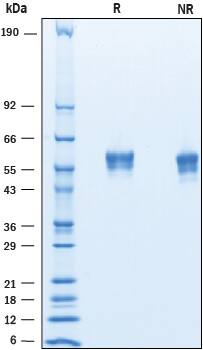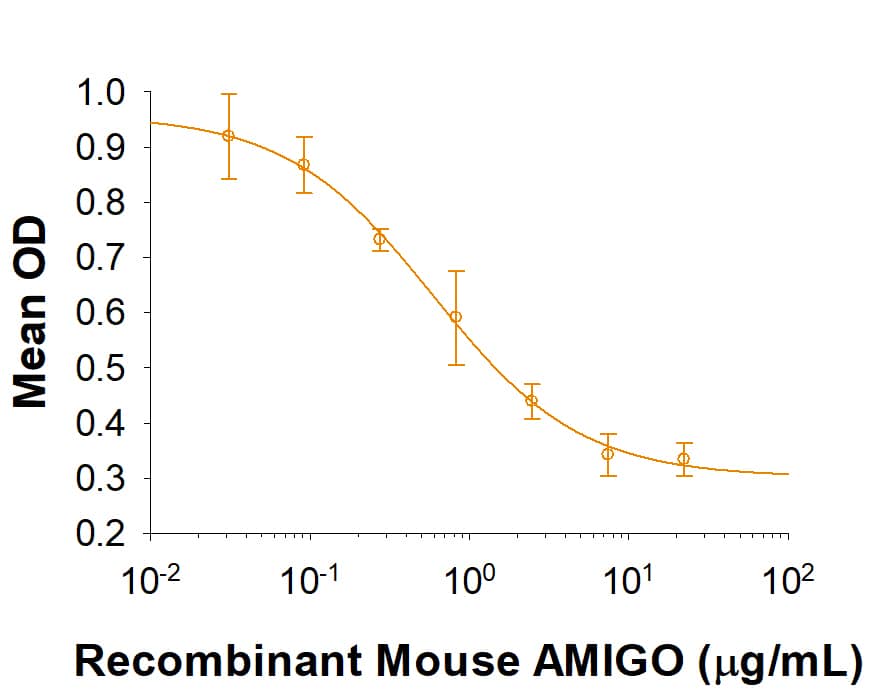Recombinant Mouse AMIGO His-tag Protein, CF
R&D Systems, part of Bio-Techne | Catalog # 10084-AM

Key Product Details
Product Specifications
Source
Gly28-Thr371, with a C-terminal 6-His tag
Purity
Endotoxin Level
N-terminal Sequence Analysis
Predicted Molecular Mass
SDS-PAGE
Activity
The ED50 for this effect is 0.1-1 μg/mL.
Scientific Data Images for Recombinant Mouse AMIGO His-tag Protein, CF
Recombinant Mouse AMIGO His-tag Protein Bioactivity
Recombinant Mouse Amigo (Catalog # 10084-AM) inhibits IL-2 secretion by mouse T cells in the presence of anti-CD3. The ED50 for this effect is 0.1-1 μg/mLRecombinant Mouse AMIGO His-tag Protein SDS-PAGE
2 μg/lane of Recombinant Mouse AMIGO was resolved with SDS-PAGE under reducing (R) and non-reducing (NR) conditions and visualized by Coomassie® Blue staining, showing bands at 49-62 kDa.Formulation, Preparation and Storage
10084-AM
| Formulation | Lyophilized from a 0.2 μm filtered solution in PBS. |
| Reconstitution | Reconstitute at 100 μg/mL in PBS. |
| Shipping | The product is shipped at ambient temperature. Upon receipt, store it immediately at the temperature recommended below. |
| Stability & Storage | Use a manual defrost freezer and avoid repeated freeze-thaw cycles.
|
Background: AMIGO
AMIGO (Amphoterin-induced gene and ORF) is an approximately 55 kDa transmembrane cell adhesion protein. It belongs to a family of leucine‑rich repeat (LRR) containing proteins that play various roles in nervous system development and function (1). Mature mouse AMIGO consists of a 344 amino acid (aa) extracellular domain (ECD) with six tandem LRRs flanked by LRR N- and C‑terminal domains, one immunoglobulin‑like domain, a 21 aa transmembrane segment, and a 100 aa cytoplasmic domain (2). Within the ECD, mouse AMIGO shares 86% aa sequence identity with human AMIGO and 93% with rat AMIGO. AMIGO is an N‑glycosylated protein that forms homodimers by association between LRR regions (3, 4). It has homophilic and heterophilic interactions with the related AMIGO2 and AMIGO3 proteins (2). AMIGO is expressed along developing and mature neuronal fiber tracts on neurons, astrocytes, and oligodendrocytes (2, 4). It promotes the extension and branching of hippocampal and cortical neurons (2, 4). It also supports neuronal survival following apoptotic stimulation (4). AMIGO directly associates with the potassium channel Kv2.1 and enhances ion conductance through the channel (5). Kv2.1 localization and activation is regulated by phosphorylation, but phosphorylation status does not alter its interaction with AMIGO (5, 6). Our data show that AMIGO act as ligand that inhibit anti-CD3 induced IL-2 secretion on CD3+ T cells, suggesting that it may be involved in T cell suppression.
References
- de Wit, J. et al. (2011) Annu. Rev. Cell Dev. Biol. 27:697.
- Kuja-Panula, J. et al. (2003) J. Cell Biol. 160:963.
- Kajander, T. et al. (2011) J. Mol. Biol. 413:1001.
- Chen, Y. et al. (2012) J. Cell. Physiol. 227:2217.
- Peltola, M.A. et al. (2011) EMBO Rep. 12:1293.
- Park, K.-S. et al. (2006) Science 313:976.
Long Name
Alternate Names
Gene Symbol
UniProt
Additional AMIGO Products
Product Documents for Recombinant Mouse AMIGO His-tag Protein, CF
Product Specific Notices for Recombinant Mouse AMIGO His-tag Protein, CF
For research use only

